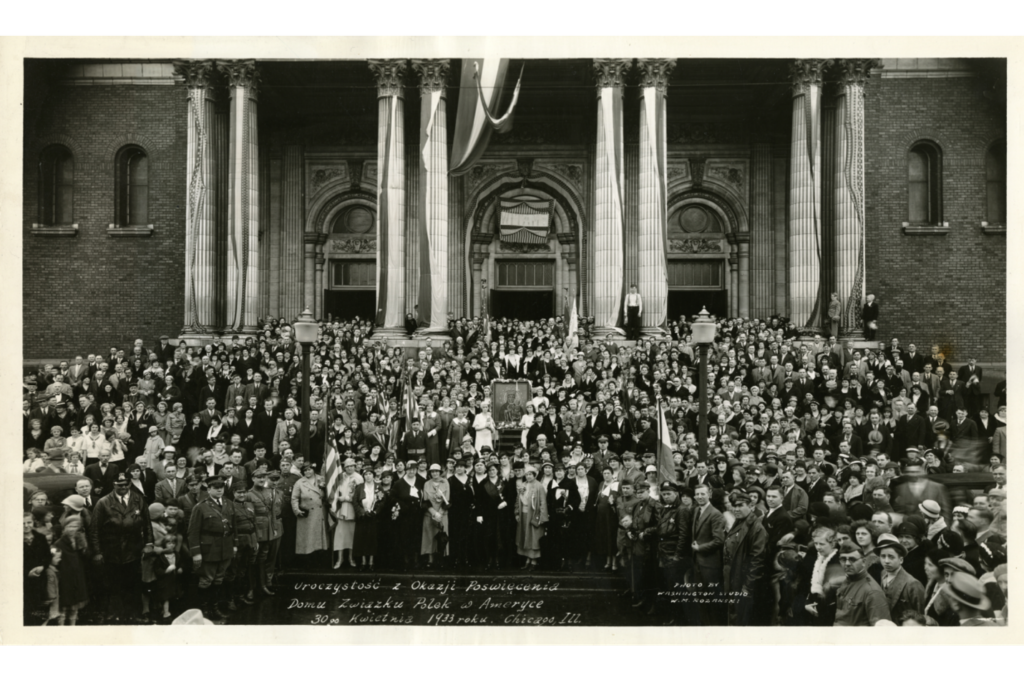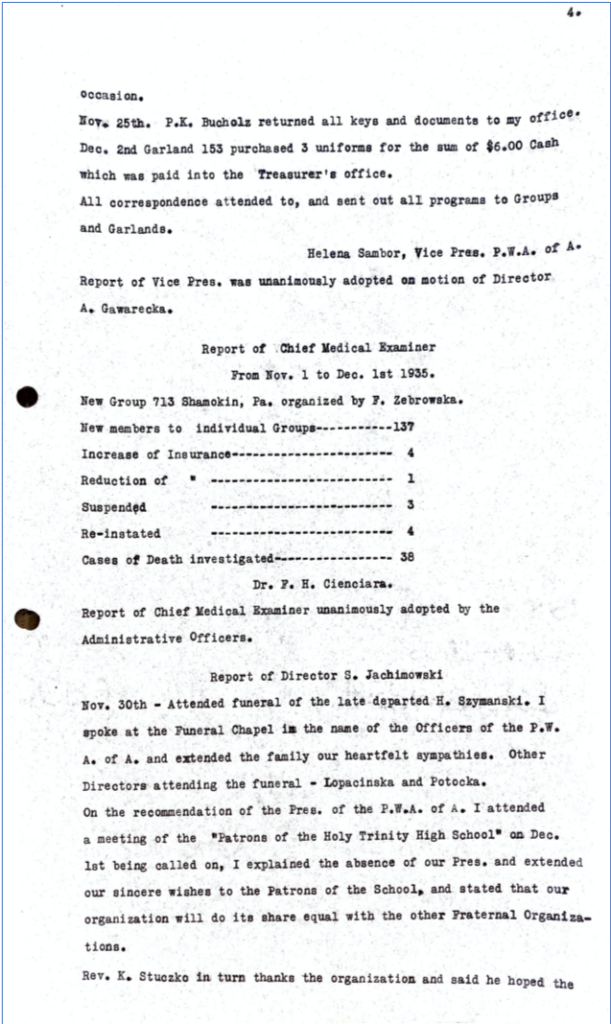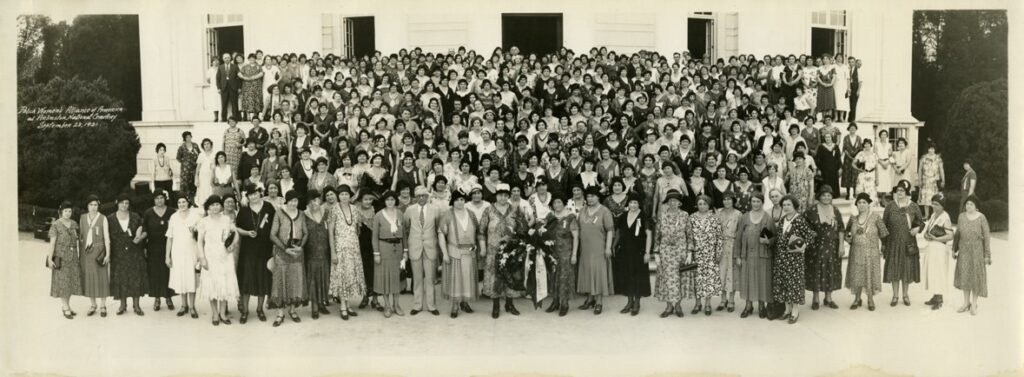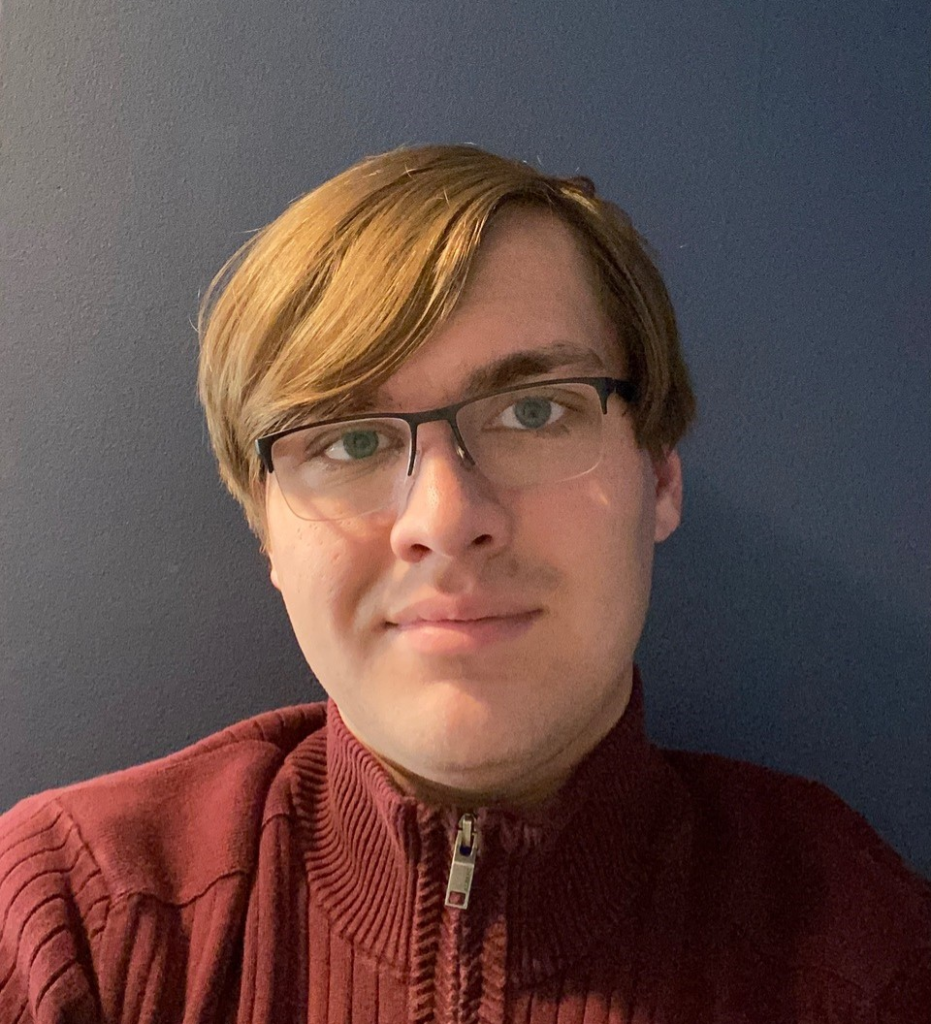This post is part of the WLA blog’s 2022 series written by guest writers. These writers are graduate students in the Public History program at Loyola University Chicago. Each visited the archives during Fall 2021, delved into the collections, and wrote about a topic not yet explored here. We are excited to share their research and perspectives!

Photo URL Link: https://luc.access.preservica.com/uncategorized/IO_aabc534b-ebed-4eb3-afe0-6144a8509cd9/
Featuring an assortment of different primary sources that researchers and historians of Polish American history can utilize, the records of the Polish Women’s Alliance of America held within the Women Leadership Archives (WLA) are a substantial tool that may help to uncover new histories about the work that Polish American women did for the Polish American community, during the 20th and Early-21st centuries. Donated in 2006 by then President and Treasurer of the PWAA, Virginia Sikora and Barbara M. Miller respectively, the records that the WLA possesses offer a variety of perspectives into an organization that has long stood as a voice for many Polish immigrants that have resided within the United States over the course of the last century [1]. Not only do the PWAA records offer a cultural, economical, and social look at Polish American society and the PWAA’s work between 1900 and 2006, but they furthermore provide a broader view into the experiences that Polish American Women went through to represent Polish Americans within American society during this time period. Altogether, this collection has the potential of serving as the base for a variety of political, social, and cultural historical works focused on Polish Americans and Polish American women.

One of the most prominent resources within the collection that offer a glimpse into the organization and business of the PWAA are the “Meeting Minutes” documents (Figure 1). Spread out over five boxes within the collection, these documents provide a minute-by-minute account of the PWAA Board of Directors meetings from 1935 to 1967. Organized by date and meeting number, they present researchers with a look into the administrative work of the PWAA and what they did for the Polish American community. Topics such as finances, remittances to Poland, post-mortem insurance, and outreach missions to Polish American communities have recorded within the documents, offering a detailed look into how the PWAA conducted its business, as well how they cast their influence onto the Polish American community within the United States and abroad [2].
Figure 1. This page from a Meeting Minutes Document shows a small variety of the activities that the PWAA Board of Directors dealt with during their meetings. As a standalone primary source, it showcases the sophistication and professional standards of the PWAA, as well as how the women running the organization themselves chose to record and catalogue their practices and undertakings. If combined with other sources, researchers may be able to piece together unique histories and perspectives of the administrative side of the organization [6].
Competing with the Meeting Minutes as another strong primary source of the PWAA’s history are a combined total of 21 diaries and ledgers that date back to the beginnings of the organization. One of the more notable items in this series is a diary titled “Janouskovec”, in which some of the first meetings of the PWAA are recorded from the year 1900 (Figure 2) [3]. Meanwhile, ledgers, such as that of PWAA Group 116’s, provide names, birthplaces, and other info of the women involved in different groups of the organization. (Figure 3) [4]. Overall, this series may help researchers to gain more insight into the social and demographic history of the PWAA.




Aside from physical items, a large majority of the PWAA collection have also been digitized (Figure 4). Available through Preservica, the WLA’s digitized collection of PWAA material include not only photos and other valuable documents, but also the entire collection of the organization’s magazine, Głos Polek or “Polish Women’s Voice” that ran for over 100+ years. With over 3,000+ articles of Głos Polek alongside the collection of group photos featuring representatives and leader of the PWAA, the digitized collection serves as a useful primary source for anyone hoping to see how the PWAA communicated with its followers, and the American populace (Figure 5 and 6) [5]. However, as extensive as the WLA collection of Głos Polek is, its contents bring to light one of the major hurdles that some researchers and historians may face when tackling the PWAA collections material.

Despite the usefulness of the PWAA collection in its ability to open new frontiers into Polish American and Polish Women’s history, researchers and historians must jump the hurdle of a language barrier. Though not every resource within the collection, such as the meeting minutes documents and some of the later issues of Głos Polek, have been presented or recorded in Polish, a large majority of the diaries, ledgers, and national convention documents are. The situation becomes slightly more difficult in the case of the diaries and ledgers, as most of them have been written in a very hard to read cursive font (Figure 7). For researchers and historians not fluent in Polish, or who have trouble reading cursive, being able to extract any useful primary information from these resources may prove difficult.

Nonetheless, the PWAA collections available through the WLA feature a unique variety of Polish American and Polish Women’s history and should be further recognized as a useful resource for historians and researchers of the Polish American community during the 20th and 21st centuries. Altogether, these records offer resources that look into the experiences of the Polish American Women that helped to build and maintain an organization that not only supported the Polish American immigrant community, but also helped in establishing immigrant women as a powerful force within the Women’s suffrage movement. Though accessibility to the records may be limited by language, translators and modern-day technologies can help bridge the gap for researchers who may not know Polish or who have trouble reading cursive. While this post only covers a small majority of the PWAA collection that the WLA possesses, it has brought attention to three parts of the collection that could provide researchers and historians alike a deeper insight to how Polish American women forged, organized, and managed a movement that has lasted into the present day. Furthermore, it presents the experiences of these women in the form of a variety of both digitized and physical content that may allow researchers and historians to craft new histories of the experiences that Polish immigrants themselves faced during the 20th century.

Kordian is a graduate student at Loyola University Chicago who specializes in East Asian and American history. His research interests include Japanese Military and Cultural history, as well as American Military and Political history between the 19th and 21st centuries.
Endnotes
[1] Women and Leadership Archives, Loyola University Chicago. “Polish Women’s Alliance of America Records 1900-2006, n.d.,” accessed Nov. 13, 2021. https://www.luc.edu/media/lucedu/wla/pdfs/Polish_Womens_Alliance_of_America.pdf.
[2] Women and Leadership Archives, Loyola University Chicago. Polish Women’s Alliance of America Records 1900-2006, n.d., Series 2: Meeting Minutes of the Board of Directors, 1935-197, Boxes 1-5.
[3] Women and Leadership Archives, Loyola University Chicago. “Janouskovec,” Polish Women’s Alliance of America Records 1900-2006, n.d., Series 4: Ledgers/Diaries, 1900- 1987, Box 8.
[4] Women and Leadership Archives, Loyola University Chicago. “Grupa No. 116, Maryi Koropricki w wiazku Polek w Ameryce,” Polish Women’s Alliance of America Records 1900-2006, n.d., Series 4: Ledgers/Diaries, 1900-1987, Box 8.
[5] “Digital Collections,” Women and Leadership Archives at Loyola University Chicago, accessed Nov. 14th, 2021, https://www.luc.edu/wla/digital_collections.shtml.
[6] Women and Leadership Archives, Loyola University Chicago. “Meeting Minutes No. 4, December 3rd, 1935,” Polish Women’s Alliance of America Records 1900-2006, n.d., Series 2: Meeting Minutes of the Board of Directors, 1935-1967, Box 1, Folder 1-3, Pg. 4.
[7] Women and Leadership Archives, Loyola University Chicago. “Janouskovec,” Polish Women’s Alliance of America Records 1900-2006, n.d., Series 4: Ledgers/Diaries, 1900- 1987, Box 8, Pg. 3.
[8] Women and Leadership Archives, Loyola University Chicago. “Grupa No. 116, Maryi Koropricki w wiazku Polek w Ameryce,” Polish Women’s Alliance of America Records 1900-2006, n.d., Series 4: Ledgers/Diaries, 1900-1987, Box 8, Pg. 1.
[9] Women and Leadership Archives, Loyola University Chicago. Polish Women’s Alliance of America at Arlington National Cemetery, Sept. 22nd, 1931, Digital Photo, https://luc.access.preservica.com/uncategorized/IO_194bfa01-0872-4416-bdaf- de32cb768a0b/.
[10] Women and Leadership Archives, Loyola University Chicago. “Głos Polek, 1902-1903, No. 01,” Polish Women’s Alliance of America Records 1900-2006, n.d., Series 7: Newspapers, 1910-1996, https://luc.access.preservica.com/uncategorized/IO_49262070- d33f-40c1-aa15-cb5799bbd212/.
[11] Women and Leadership Archives, Loyola University Chicago. “Głos Polek, 1918, No. 34,” Polish Women’s Alliance of America Records 1900-2006, n.d., Series 7: Newspapers, 1910-1996, https://luc.access.preservica.com/uncategorized/IO_cb31bd7d-5850-41c6- 94c8-1c063ff80085/.
[12] Women and Leadership Archives, Loyola University Chicago. “Tow. Wolna Polska Gr. 298 Zw. Polek W. Ameryce,” Polish Women’s Alliance of America Records 1900-2006, n.d., Series 4: Ledgers/Diaries, 1900-1987, Box 12, Pg. 3.
Loyola University Chicago’s Women and Leadership Archives Blog is designed to provide a positive environment for the Loyola community to discuss important issues and ideas. Differences of opinion are encouraged. We invite comments in response to posts and ask that you write in a civil and respectful manner. All comments will be screened for tone and content and must include the first and last name of the author and a valid email address. The appearance of comments on the blog does not imply the University’s endorsement or acceptance of views expressed. Questions? Please contact the WLA at wlarchives@LUC.edu.
